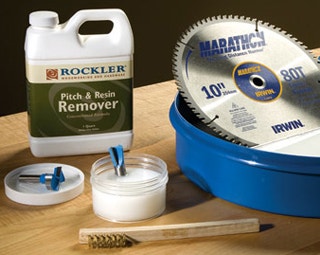How Often to Clean Saw Blades?
I know a clean table saw blade will cut better, but I've never read anywhere how often I should clean my blades? Once a month, once a week, every other day? - Max Harnisch
Rob Johnstone: It is so seldom that my knee-jerk wise Alec habit and my tendency to want to answer any and all woodworking questions align as one, but here we go: When they gets dirty. (OK, that was somehow less satisfying than I had envisioned.) If you see buildup and gunk on your blade - look closely at both faces of the blade and at the place where the carbide teeth are brazed onto the steel blade body - then you should clean it. Pick up the blade, look it over carefully, holding the blade under good light and close to your face. (This is called "gross inspection," but I am going to avoid the obvious smart-aleck retort, because the last one let me down so badly.) Pitch-rich woods like Ponderosa pine and spruce can build up gunk quickly - especially if they are not well dried. Other material, like wood that has a resin finish or paint, can create a buildup that needs to be cleaned off. If you are only using kiln-dried hardwood or man-made sheet stock, you may never need to clean your blades. Chris Marshall: Max, I probably clean my blades twice a year, but it all depends on how quickly the pitch and other resins start to build up and leave scorched-on debris. Some manufacturers say that this gunk will actually shorten the life of the carbide by overheating it during cutting. I have no evidence to support this claim, but it's good reason to keep the teeth clean anyway. I use a chemical-based blade cleaner that smells like oven cleaner. There are citrus-based options as well, if you want to take a less caustic approach. One reader once suggested that laundry detergent also works if you soak the blade in it for a spell (I tried this out, with good results). It probably takes me a half hour, if that, to go from a grimy blade to a clean one back on the saw and ready for use. I spray the blade, let the cleaner soak in and then scrub it with a plastic-bristle brush. If your blade doesn't have a factory (usually colored) coating on it, rub a little light oil or wax on the blade body once it's clean to help prevent rust. Tim Inman: The best answer I can possibly give is this: Clean it when it is dirty. Without being impertinent, it is a matter of judgment and objectivity. If you're doing the finest of fine work, you're going to notice your blade needs cleaning frequently - probably daily. If you're making chicken coops from scrap lumber, you may not notice much difference whether the blade is clean or not. Clean, sharp blades are not only a pleasure to use, they yield better work and they are a lot safer!
Keep the inspiration coming!
Subscribe to our newsletter for more woodworking tips and tricks




